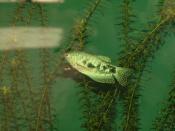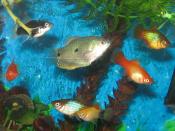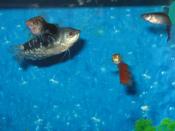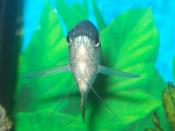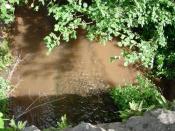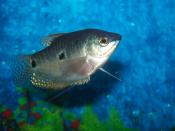This article concludes the research done by several high school students to test the effects of aquatic hypoxia on the blue gourami, Trichogaster trichopterus. Fish were transported from a 30-gallon oxygenated fish tank to individual observation chambers beginning at water levels of 250 milliliters of 100% oxygenated water. Gradually, small amounts of deoxygenated water were added to the observation chambers. As the water became increasingly deoxygenated, fish were carefully observed according to the number of gulp trips they took to the surface and the number of opercular beats of their gills per minute. The results of the experiment displayed a general increase in the number of gulp trips per minute for the results of an individual group and for the class mean results. Results also displayed a general increase followed by a decrease in the number of opercular beats per minute for both individual and class results.
IntroductionFishes, as with other aquatic organisms, must obtain a sufficient amount of oxygen in order for proper metabolism to occur.
A problem with this is presented through the examination that the dissolved oxygen of an aquatic environment is much lower than the amount of oxygen available in the air. In order to fulfill their constant demand for oxygen, fishes have developed certain organs for gas exchange and air breathing. Those fish that take oxygen from the water have developed different organs for obtaining oxygen than those who are forced to take oxygen out of the air during oxygen deficiency.
Such organs that are used in the exchange of respiratory gases within the body could include a respiratory surface, gills, lungs, a gas bladder, a pneumatic duct, stomach, and intestine, as well as organs formed in the head region such as the buccal, pharyngeal, branchial, opercular surfaces, and possibly pouches that are formed adjacent to the pharynx (Sundström 1998). For most fish, when oxygen is needed within the body the gills are used to take oxygen from the water. In the gills, water is pumped rapidly over a respiratory surface-a membrane heavily supplied with capillaries. The gas exchange occurring is assisted by a countercurrent arrangement of blood vessels (Henry 2007). This arrangement enables maximum exchange between two fluids when the two are flowing in opposite directions and have a concentration gradient between them. The exchange of fluids then leads to the diffusion of oxygen into the blood of the fish.
Under certain environmental conditions, natural or artificial, there may be times when aquatic organisms experience a depression in the amount of oxygen in the water. This is known as aquatic hypoxia and different fish have developed different mechanisms to survive in those times of oxygen depletion.
Many fish have adapted to remain taking oxygen from the water during hypoxic conditions. In order to compromise, they conserve energy by reducing metabolic activity during hypoxic exposure. These fish also slow down spontaneous activities. Therefore, as the amount of oxygen in the water decreases, so does the amount of activity observed in the fish, or other aquatic organism with the same characteristics.
For other fishes, there is another mechanism that can be used in order to suffice during times of oxygen depletion. A number of fishes can survive by breathing the air directly from the atmosphere. This method allows the amount of activity to remain unaffected, unlike those fish who cannot take oxygen from the atmosphere. Some reports even suggest that decreasing oxygen in water increases the swimming movements of air-breathing fish (Herbert, Wells 2001). A fish is considered to be an air-breather if it directly exchanges oxygen and/or carbon dioxide through respiration with the atmosphere. Air-breathers are also classified based on the presence of an air-breathing organ, commonly known as an ABO.
Aquatic air-breathers can be divided into two classifications: facultative and continuous air-breathers. Facultative air-breathers usually only turn to air-breathing when the water surrounding them becomes hypoxic or when the demand for oxygen increases (Sundström 1998). Some different kinds of facultative air-breathers include some catfish, lungfish, even some tropical fish, and numerous others.
A specific kind of tropical fish that utilizes facultative air-breathing is the Trichogaster trichopterus, or commonly, the blue gourami. In order to successfully breathe atmospheric oxygen in hypoxic conditions, the blue gourami has a specialized organ known as a labyrinth. The labyrinth is where the oxygen is forced when the gourami takes a gulp of air. Inside the labyrinth there are many small maze-like compartments of thin boney plates called lamellae. The lamellae are covered with membranes where blood passes through and is absorbed into the bloodstream (ÃÂWhat is a Labyrinth Fish?ÃÂ 2006). Without the labyrinth as its primary ABO, the blue gourami would not be able to breathe atmospheric oxygen and would probably not be able to live or strive in water with low oxygen content.
As it is the oxygen content that has the greatest effect on the metabolic processes of the blue gourami, there have also been other suggestions. The threat of predation is present everywhere for fishes, especially tropical fish, and it has been proven to be a major factor influencing the behavior of aquatic air-breathers. Since the risk of mortality increases for air-breathers with the amount of time at the surface, fish may only minimize their risk by reducing the amount of actual air-breathing. Because of this discrepancy, these fish are forced to make a trade-off between minimizing the risk of mortality and satisfying their metabolic need for oxygen (Herbert, Wells 2001).
In the studies done in this case, the blue gourami were each forced to risk their lives and take gulps of atmospheric air while also under the possible threat of predation. As the observers were not trying to act as predators in the experiment, it is natural for the fish to react to them as though they were. In every case within the experiment, the need for atmospheric oxygen prevailed over the risk of mortality and each fish continued to gulp the air as the levels of oxygen steadily decreased.
Methods and MaterialsThe collection of data in this observation took place on the sixteenth of April within the laboratory in Broadalbin, New York. The actual observation process took approximately an hour to complete. During the analysis of the blue gourami, the fish were taken from a large oxygenated tank and placed in individual holding tanks where closer observations took place. A large 600 milliliter beaker was used, along with a smaller 250 ml. beaker and a 100 ml. graduated cylinder to measure the amounts of oxygenated and deoxygenated water. A specialized device was also used to increase the levels of carbon dioxide (CO2) in a tank of stagnant water and decrease the levels of oxygen. This was the used for the source of deoxygenated water in the experiment.
Observers were instructed to abide by the following method chart to know what amounts of water needed to be added to and poured off of the observation chambers. It was also used to know which percentages of each kind of water were present at every point during the experiment and the total volume of water that was in the observation chambers at every point.
The method for obtaining the information needed to conduct the experiment included several steps. First, after the fish were transported into individual observation chambers, they were given approximately two minutes to adjust to their new environment and to steady their metabolic activities. Next, the fish were observed for one minute in 100% oxygenated water and the number of gulp trips and opercular beats were recorded. The indicated amount of deoxygenated water was added to the holding tank and the fish were given approximately one minute to adjust and then one minute to be observed again so that results could be recorded. This continued in the same manner until some of the water had to be poured off and more deoxygenated water had to be added until there was no remaining oxygenated water or until the fish had to be removed and placed back in oxygenated water before mortality occurred.
Some techniques that were used while handling the live fish involved being very still and very quiet while the fish were in immediate presence of the observers. This was instructed to create the most stress-free environment possible for the blue gourami to reduce the threat of predation and allow the fish to take their gulps as naturally as they would in their own environment.
ResultsTable 1 is a description of the results of one of the observation groups in the experiment. It reveals that at 100% oxygenated water the number of gulp trips that the fish took per minute was zero and the number of opercular beats shown by the fish was 67. As oxygenated water decreased to 90% there were still zero gulp trips and then 52 opercular beats. At 80 % oxygenated water there were three observed gulp trips and 74 opercular beats. At 70% oxygenated water there was one gulp trip and 68 opercular beats. At 60% there was one gulp trip and 72 opercular beats. At 50% there was one gulp trip and 73 opercular beats. At 40% there were six gulp trips and 91 opercular beats. At 30% there were seven gulp trips and 61 opercular beats. At 20% there were 29 gulp trips and 70 opercular beats. After this observation, the blue gourami began to show signs of near mortality so the fish was placed back in the oxygenated tank and the experiment was ended. It should also be noted that between the timed observations, the number of gulp trips and opercular beats were still being recorded separately.
Table 2 represents a description of the mean of the total class results of the observations when all of the groups combined their data. It reveals that at 100% oxygenated water the number of gulp trips that the fish took per minute was zero and the number of opercular beats shown by the fish was 58.4. As oxygenated water decreased to 90% there were 0.6 gulp trips and then 59.6 opercular beats. At 80 % oxygenated water there were 0.8 average observed gulp trips and 70.8 opercular beats. At 70% oxygenated water there were 1.8 gulp trips and 72.8 opercular beats. At 60% there were 2.6 gulp trips and 66.2 opercular beats. At 50% there were 3.4 gulp trips and 73.4 opercular beats. At 40% there were 5.8 gulp trips and 75.6 opercular beats. At 30% there were 6.4 gulp trips and 68 opercular beats. At 20% there were 11.8 gulp trips and 68.8 opercular beats. At 10% there were 29 gulp trips and 40.7 opercular beats. At 0% there were 34.5 gulp trips and 10 opercular beats. It should be noted that at 10% and 0% oxygenated water the number of gulps were based on the fact that some groups recorded continuous gulps taken by their fish and that not every group had results for some of the final levels of oxygenated water.
Graph 1 is a comparison of the number of gulp trips per minute that were recorded by an individual group to the class mean number of gulp trips per minute. Both sets of data show an increase in number of gulp trips. The trend can be seen easily when information is represented in a visual manner.
Graph 2 is a comparison of the number of opercular beats per minute that were recorded by an individual group to the class mean number of opercular beats per minute. The trend in this data is also easily seen when represented in a visual manner. In this comparison there is a different trend in data than in the comparison of gulp trips per minute.
DiscussionThroughout all of the information collected during the observations, there were many trends in data. It is easy to see the trend in data when represented physically, such as in a line graph like the ones presented. In this experiment, the trends show that the number of gulp trips per minute that were taken by the blue gourami continuously increased as the concentration of oxygenated water decreased throughout the observation period. This trend was seen in both group results and in class mean results. Another trend that was observed in the experiment was seen in the comparison of number of opercular beats per minute recorded by a group and then given from the class mean results. In this particular trend, the number of opercular beats is observed as increasing and then decreasing throughout the observation period ad the concentration of oxygenated water steadily decreased.
As the threat of predation was known to be a factor that could have possibly influenced the final data, it is possible that it did have an effect on the performed experiment. With the threat of a predator present, normally an air-breathing fish would reduce its air-breathing frequency. This would result in less gulp trips to the surface. Although the results of this experiment did not show a decrease in gulp trips over time, it is possible to reason that if the observers were not present at the time of increasing hypoxia, the number of gulp trips per minute would be higher. This deduction was not proven by this experiment but with further observations, it could be a worthy subject to discuss in future blue gourami experiments.
ReferencesHerbert, N.A., Wells, R.M.G. ÃÂThe aerobic physiology of the air-breathing blue gourami,ÃÂ ÃÂ School of Biological Sciences, The University of Auckland. Auckland, New Zealand. 2001.
Sundström, Fredrick. ÃÂAir Breathing in Fishes.à1998. Online. http://vivaldi.zool.gu.se/ekologi/personal/fredrik/airbreather.htm 1 May 2005.
ÃÂWhat is a Labyrinth Fish?ÃÂ Online. http://freshaquaium.about.com/cs/fishspecies/1/b1will113000.htm 25 April 2006.
